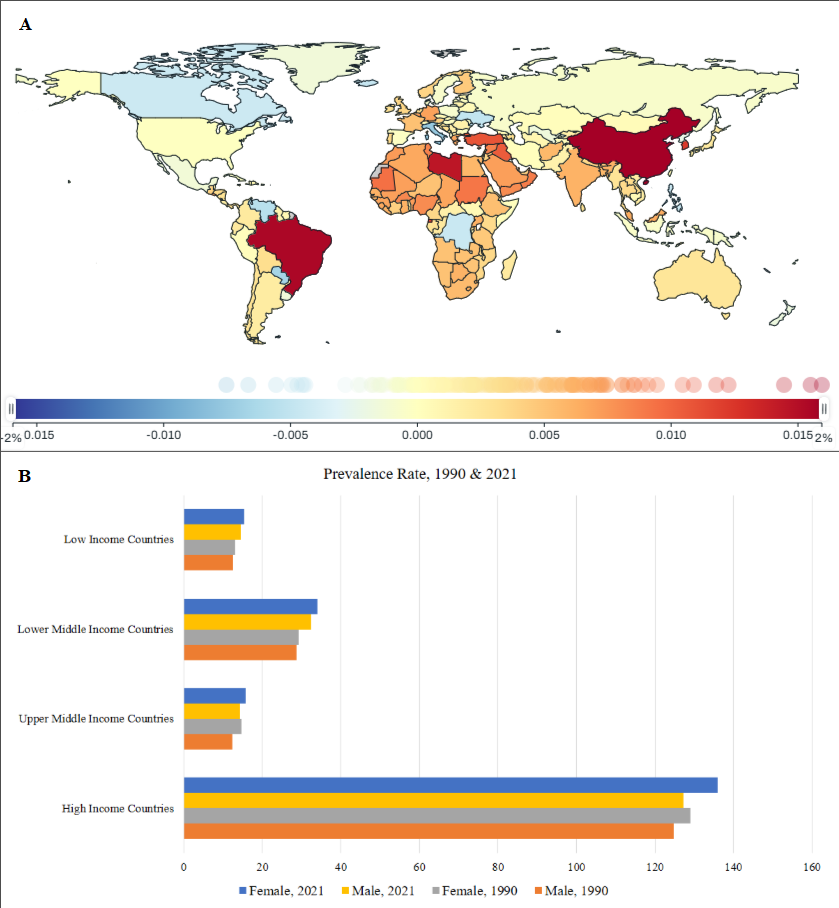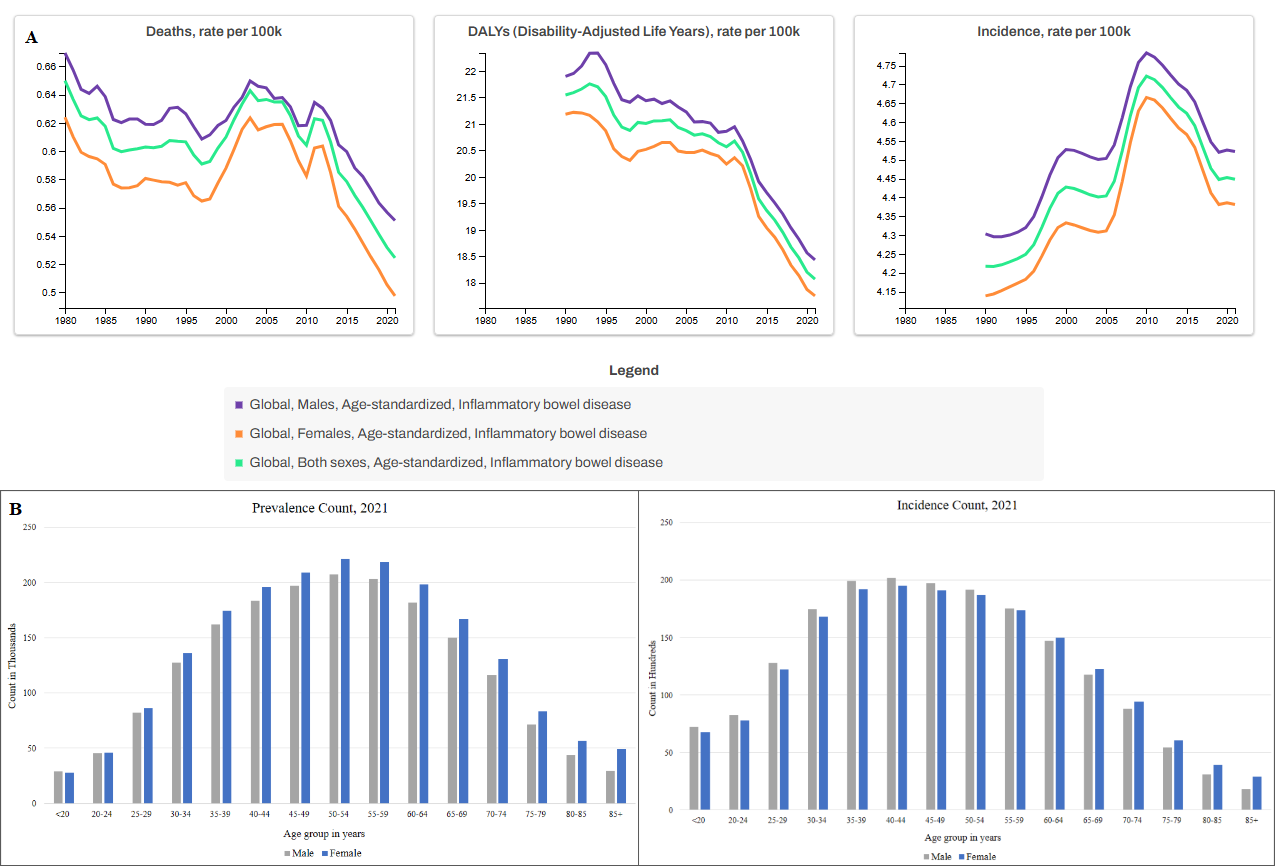Tuesday Poster Session
Category: IBD
P5316 - Enigmatic Trends and Regional Disparities of Inflammatory Bowel Disease Across 204 Countries and Territories (1990-2021): Global Analysis From the Global Burden of Disease 2021
Tuesday, October 28, 2025
10:30 AM - 4:00 PM PDT
Location: Exhibit Hall
- YJ
Yujin Jeong, MD
Elmhurst Hospital Center / Icahn School of Medicine at Mount Sinai
New York, NY
Presenting Author(s)
Award: ACG Presidential Poster Award
Namra Gohil, MBBS1, Aasvi Gohil, MBBS2, Jay Kakadiya, MBBS3, Shreya Beniwal, MBBS4, Yujin Jeong, MD5,Ashvin Varadharajan, MBBS6
1Medical College Baroda, Vadodara, Gujarat, Vadodara, Gujarat, India; 2GMERS Medical College Gotri, India, Vadodara, Gujarat, India; 3Government Medical College, Surat, India, Surat, Gujarat, India; 4Lady Hardinge Medical College, New Delhi, Delhi, India; 5Elmhurst Hospital Center / Icahn School of Medicine at Mount Sinai, New York, NY; 6Armed Forces Medical College Pune, Pune, Maharashtra, India
Introduction: Inflammatory Bowel Disease (IBD) is an emerging global health concern, with rising burden across diverse regions and populations. Once considered a disease of the Western world, IBD is now increasingly recognized worldwide. Understanding its distribution is vital for identifying risk factors, predicting trends, and developing effective strategies to manage its burden.
Methods: We analyzed global burden of disease data to estimate incidence, prevalence, deaths, disability-adjusted life years (DALYs), and years lived with disability (YLDs). Rates (per 100,000) and annual percentage change (APC) were calculated for each variable. Comparative analysis was performed by age, gender, year, and region.
Results: IBD prevalence rose from 2.17 million (95% UI: 1.90–2.53 million) in 1990 to 3.83 million (95% UI: 3.31–4.51 million) in 2021. China had the highest APC in prevalence rate (1.59%), while Italy had the greatest decline (0.75%). Fig 1(A) shows notable APC increases in Asian, African, and Latin American countries, indicating shifting global patterns. Fig 1(B) compares age-standardized prevalence rates (ASPR) by economic status, revealing rates nearly five times higher in high-income countries (male: 127; female: 136) than in low- and middle-income nations The ASPR has also increased from 1990 to 2021 in nearly all economic groups. Age-standardized death and DALYs rates have declined over three decades (death rate: 0.6 in 1990 to 0.52 in 2021), though some peaks remain, reflecting ongoing management challenges. Fig 2(A) shows incidence peaked around 2010 but has since slightly declined, possibly indicating improved detection and management. Age-group analysis of prevalence in 2021 (Fig 2(B)) reveals a bell-shaped curve peaking at age 50–54 (male: 207k; female: 221k). Incidence shows a leftward shift, peaking at age 40–44 (male: 20k; female: 19k), suggesting a younger age of onset. Males have higher age-standardized death and DALYs rates than females.
Discussion: The rising prevalence and expanding distribution of IBD in low- and middle-income countries highlight the need for targeted public health efforts in regions with accelerating trends, to reduce disease burden and improve outcomes.

Figure: Fig 1: (A) APC in the prevalence rate of IBD, 1990 – 2021. (B) Comparing age-standardized prevalence rate of IBD according to per capita income, 1990 & 2021

Figure: Fig 2: (A) Trends of death, DALYs, and Incidence rate of IBD, 1990 – 2021. (B) Age-group-wise incidence and prevalence rate of IBD, 2021
Disclosures:
Namra Gohil indicated no relevant financial relationships.
Aasvi Gohil indicated no relevant financial relationships.
Jay Kakadiya indicated no relevant financial relationships.
Shreya Beniwal indicated no relevant financial relationships.
Yujin Jeong indicated no relevant financial relationships.
Ashvin Varadharajan indicated no relevant financial relationships.
Namra Gohil, MBBS1, Aasvi Gohil, MBBS2, Jay Kakadiya, MBBS3, Shreya Beniwal, MBBS4, Yujin Jeong, MD5,Ashvin Varadharajan, MBBS6. P5316 - Enigmatic Trends and Regional Disparities of Inflammatory Bowel Disease Across 204 Countries and Territories (1990-2021): Global Analysis From the Global Burden of Disease 2021, ACG 2025 Annual Scientific Meeting Abstracts. Phoenix, AZ: American College of Gastroenterology.
Namra Gohil, MBBS1, Aasvi Gohil, MBBS2, Jay Kakadiya, MBBS3, Shreya Beniwal, MBBS4, Yujin Jeong, MD5,Ashvin Varadharajan, MBBS6
1Medical College Baroda, Vadodara, Gujarat, Vadodara, Gujarat, India; 2GMERS Medical College Gotri, India, Vadodara, Gujarat, India; 3Government Medical College, Surat, India, Surat, Gujarat, India; 4Lady Hardinge Medical College, New Delhi, Delhi, India; 5Elmhurst Hospital Center / Icahn School of Medicine at Mount Sinai, New York, NY; 6Armed Forces Medical College Pune, Pune, Maharashtra, India
Introduction: Inflammatory Bowel Disease (IBD) is an emerging global health concern, with rising burden across diverse regions and populations. Once considered a disease of the Western world, IBD is now increasingly recognized worldwide. Understanding its distribution is vital for identifying risk factors, predicting trends, and developing effective strategies to manage its burden.
Methods: We analyzed global burden of disease data to estimate incidence, prevalence, deaths, disability-adjusted life years (DALYs), and years lived with disability (YLDs). Rates (per 100,000) and annual percentage change (APC) were calculated for each variable. Comparative analysis was performed by age, gender, year, and region.
Results: IBD prevalence rose from 2.17 million (95% UI: 1.90–2.53 million) in 1990 to 3.83 million (95% UI: 3.31–4.51 million) in 2021. China had the highest APC in prevalence rate (1.59%), while Italy had the greatest decline (0.75%). Fig 1(A) shows notable APC increases in Asian, African, and Latin American countries, indicating shifting global patterns. Fig 1(B) compares age-standardized prevalence rates (ASPR) by economic status, revealing rates nearly five times higher in high-income countries (male: 127; female: 136) than in low- and middle-income nations The ASPR has also increased from 1990 to 2021 in nearly all economic groups. Age-standardized death and DALYs rates have declined over three decades (death rate: 0.6 in 1990 to 0.52 in 2021), though some peaks remain, reflecting ongoing management challenges. Fig 2(A) shows incidence peaked around 2010 but has since slightly declined, possibly indicating improved detection and management. Age-group analysis of prevalence in 2021 (Fig 2(B)) reveals a bell-shaped curve peaking at age 50–54 (male: 207k; female: 221k). Incidence shows a leftward shift, peaking at age 40–44 (male: 20k; female: 19k), suggesting a younger age of onset. Males have higher age-standardized death and DALYs rates than females.
Discussion: The rising prevalence and expanding distribution of IBD in low- and middle-income countries highlight the need for targeted public health efforts in regions with accelerating trends, to reduce disease burden and improve outcomes.

Figure: Fig 1: (A) APC in the prevalence rate of IBD, 1990 – 2021. (B) Comparing age-standardized prevalence rate of IBD according to per capita income, 1990 & 2021

Figure: Fig 2: (A) Trends of death, DALYs, and Incidence rate of IBD, 1990 – 2021. (B) Age-group-wise incidence and prevalence rate of IBD, 2021
Disclosures:
Namra Gohil indicated no relevant financial relationships.
Aasvi Gohil indicated no relevant financial relationships.
Jay Kakadiya indicated no relevant financial relationships.
Shreya Beniwal indicated no relevant financial relationships.
Yujin Jeong indicated no relevant financial relationships.
Ashvin Varadharajan indicated no relevant financial relationships.
Namra Gohil, MBBS1, Aasvi Gohil, MBBS2, Jay Kakadiya, MBBS3, Shreya Beniwal, MBBS4, Yujin Jeong, MD5,Ashvin Varadharajan, MBBS6. P5316 - Enigmatic Trends and Regional Disparities of Inflammatory Bowel Disease Across 204 Countries and Territories (1990-2021): Global Analysis From the Global Burden of Disease 2021, ACG 2025 Annual Scientific Meeting Abstracts. Phoenix, AZ: American College of Gastroenterology.

